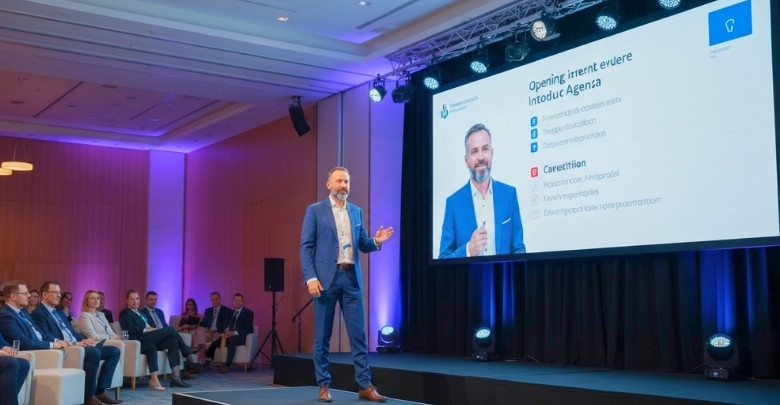Conferences are exciting spaces where ideas are shared, connections are made, and discussions spark new possibilities. As a moderator, you play a key role in shaping the energy and flow of the session. Your introduction sets the tone—it’s the moment to establish warmth, authority, and enthusiasm. But how do you strike the right balance between professionalism and approachability?
If you’ve ever wondered how do you introduce yourself as a conference moderator, the answer is simple.
To introduce yourself as a conference moderator, start with a friendly hello, say your name, and mention that you are the moderator. Briefly explain why you’re part of the event. Keep it short and show excitement for the session. Let the audience know you’ll guide the discussion and welcome their questions.
In the following guide, you’ll learn how to craft an effective self-introduction that makes a strong first impression and sets the perfect tone for your conference.
How Do You Introduce Yourself as a Conference Moderator?
Starting a session as a moderator is more than reading a script; it shapes the audience’s trust. Your opening lines, tone, and approach set the rhythm of discussions, allowing speakers and listeners to feel engaged from the very start. Here’s how to introduce yourself confidently and set a welcoming tone for the session.

Step 1: Begin With a Friendly Greeting
- Offer a warm hello that feels genuine, because audiences respond positively when they sense sincerity and presence.
- Maintain natural eye contact, showing confidence while signaling openness, which makes attendees feel welcomed into the environment.
- Smile when addressing participants, as a simple gesture adds energy, comfort, and creates an approachable atmosphere.
Step 2: State Your Full Name Clearly
- Announce your name with steady clarity, ensuring participants remember who guides them through every scheduled segment.
- Speak at a moderate pace, since rushing through your introduction may confuse attendees and reduce your credibility.
- Use a tone that reflects both professionalism and warmth, ensuring your presence feels natural and relatable throughout.
Step 3: Mention Your Role As Moderator
- Tell the audience you’re the moderator, reinforcing why you stand on stage guiding discussions and engagement.
- Clarify your role with confident words, ensuring listeners understand you’ll manage timing, transitions, and speaker interactions.
- Keep this explanation brief yet informative, avoiding unnecessary detail that distracts from the excitement awaiting ahead.
Step 4: Share Why You’re Part of the Event
- Provide a quick reason why you’re moderating, establishing relevance without overwhelming attendees with unnecessary background.
- Highlight professional expertise or personal connection, allowing people to see authentic alignment with the event’s purpose.
- Create a sense of relatability by linking your presence to shared goals, fostering trust before discussions begin.
Step 5: Express Enthusiasm for the Session
- Show excitement in your voice, making attendees feel eager about participating in an engaging, interactive discussion.
- Share one meaningful detail about the session’s theme, sparking curiosity and anticipation before the dialogue begins.
- Keep enthusiasm authentic, because audiences recognize genuine energy and connect more when enthusiasm feels unscripted.
Step 6: Set Expectations for Interaction
- Let participants know you’ll guide conversations, ensuring speakers remain focused and discussions maintain productive flow.
- Invite attendees to prepare questions, signaling their voices matter, which enhances collective participation and session vibrancy.
- Outline session flow briefly, so everyone feels informed about timing, topics, and audience involvement opportunities.
Step 7: Encourage Openness for Questions
- Tell listeners you welcome questions, building a safe space where curiosity drives deeper conversations and understanding.
- Assure attendees that their input is valued, encouraging them to voice perspectives and expand shared knowledge.
- Close your introduction by affirming inclusivity, leaving participants confident about speaking during or after discussions.
Introducing yourself as a conference moderator doesn’t need to be complicated. It’s about clarity, energy, and connection. You should know that conferences happen worldwide in regions like Canada, Germany, India, and Singapore. Professionals attending upcoming conferences in Canada often observe patterns similar to global events, helping them better prepare for diverse audiences and cultural settings.
Samples of Different Types of Moderator Introductions:
1. Formal Conference Style
“Good morning, ladies and gentlemen. My name is [Name], and I am honored to serve as your moderator today. Our session will focus on [Topic], and together we’ll explore insights from our distinguished speakers. Thank you for being here.”
2. Friendly and Warm
“Hi everyone! I’m [Name], and I’ll be your moderator for this session. I’m really excited because today’s discussion is about [Topic], which I know you’ll find both useful and inspiring. Let’s get started by meeting our amazing speakers.”
3. Short and Professional
“Hello, I’m [Name], your moderator for this event. Today’s session will highlight [Topic], and we’ll also leave time for your questions. Let’s begin with our first speaker, [Speaker Name].”
4. Interactive Style
“Welcome, everyone! I’m [Name], and I’ll be guiding today’s session. Before we begin, I’d like you to think about one question you hope this discussion will answer. Keep it in mind—we’ll come back to it during our Q&A.”
5. Energetic and Engaging
“Hello everyone, I’m [Name], and I can already feel the excitement in this room! I’ll be moderating today’s session on [Topic]. We have incredible speakers lined up, so let’s dive right into the conversation.”
6. Virtual Event Style
“Hi there, and welcome to our online session. I’m [Name], and I’ll be your moderator. Please use the chat for your questions, and we’ll address them during the Q&A. Now, let’s get started with our first speaker.”
7. Youthful/Student-Friendly
“Hey, everyone! I’m [Name], and I’ll be your moderator today. We’re going to dive into [Topic], and I promise to keep things simple, quick, and fun. Let’s welcome our speakers with a round of applause.”
Common Mistakes to Avoid When Introducing Yourself
Being a moderator can feel exciting but also stressful. Your first words matter because they set the mood for everyone. A poor start can confuse the audience and hurt the flow. Avoid these mistakes to keep things smooth and clear.
- Too Serious Tone: If you sound stiff, people may lose interest quickly. Use light words and speak like you are talking with friends.
- Rushing Words: Talking too fast makes it hard to follow. Slow down, breathe often, and let people take in your words.
- Extra Stories: Long stories about yourself distract from the session. Share only details that help the event feel clear and useful.
- Flat Voice: A plain voice feels dull and tiring. Change your pitch a little and smile, so energy flows into your talk.
- No Audience Link: Not looking at people creates distance. Smile, make eyes for a second, and make everyone feel part of the room.
- Unclear Role: If you don’t say your role, people might get confused. Tell them you will guide the talk and timing.
- Going Over Time: A long intro breaks the event flow. Keep it short, respect time, and move quickly into the main part.
Key Elements to Include in Your Self-Introduction
Standing in front of an audience can feel both exciting and slightly scary at the same time. Your introduction shapes how people listen, so it’s worth planning carefully. Every word and every action helps build trust right from the start. Follow these key elements to include in your self-introduction.
Name and Role
The first step is to tell people your name and your role. Saying this clearly helps everyone know who you are. Don’t rush, speak slowly so people can hear you properly. A simple “Hi, I’m [Name], your moderator” works great.
Connection to Topic
After introducing yourself, share why you are part of this event. It could be your background, work, or interest in the subject. This makes people see you as someone who belongs on stage. When the audience understands your link, they listen more closely.
Purpose of Session
Next, talk about the goal of the session. Keep it short, so people don’t lose attention. Tell them what they can expect by the end of the discussion. This gives clarity and helps everyone stay focused.
Session Flow
Audiences like to know how things will go. You can quickly explain the order of speakers and activities. Let them know when questions will be allowed. A clear outline gives everyone a sense of comfort and order.
Introduce Speakers
If you have panelists or guest speakers, introduce them briefly. Mention their role and why they are part of the topic. Do not read a long biography because it can bore the audience. Keep it simple and respectful while highlighting their importance.
Audience Involvement
A moderator should make the audience feel included. Encourage them to share questions or thoughts at the right time. This creates a lively and engaging environment where everyone feels heard. When people are involved, the whole session feels more successful.
Moderator Qualities
While giving your introduction, let your presence show confidence and calmness. Speak clearly, smile, and keep your energy steady. These actions reflect the qualities of a good conference moderator, which inspire trust in both speakers and the audience. Your behavior sets the mood for the entire discussion.
Respectful Language
Always use polite words and be careful with names. Pronounce them correctly to show respect to the speakers and participants. Simple, respectful behavior makes a big difference in how people respond. A welcoming environment starts with inclusive and kind language.
How to Keep Your Introduction Short and Professional?
An introduction should never feel heavy or stretched. People listen more carefully when your words are short and sharp. Staying professional also shows you respect their time. With the right balance, you sound confident while keeping the focus on the session. Here are a few tips on keeping it short and professional.
- Clear Opening: Start with a strong hello that sounds natural. A friendly tone makes people feel welcome and sets the stage properly.
- State Name: Say your name clearly and pause briefly. This makes sure everyone hears it correctly and remembers who is speaking.
- Mention Role: Introduce your role without adding extra details. Keeping it simple prevents confusion and lets the audience know your position quickly.
- Session Purpose: Share the purpose of the session in plain words. A short line gives direction without adding extra, unnecessary information.
- Highlight Speakers: Give a brief speaker introduction without listing everything. Mention their role and why they are important to the discussion.
- Encourage Questions: Tell the audience when questions are welcome during the session. This builds clarity and avoids interruptions during the main discussions.
- Time Awareness: Keep your introduction under two minutes to respect schedules. A shorter beginning ensures the session moves forward smoothly without delay.
How to Transition From Your Introduction to the Event Agenda?
Moving from your introduction to the agenda is important. It connects the audience to what’s coming next. A smooth transition keeps attention strong and makes the session feel organized. Here’s how to smoothly move from your introduction to the event agenda while keeping the audience engaged.
Connect Your Role
After introducing yourself, link your role to the session. This creates trust and explains why you’re guiding the discussion ahead. Sharing purpose helps people see the bigger picture. A confident link sets the mood for the entire session.
Bridge With Session Purpose
State the main goal of the event before presenting details. It helps people understand what they can expect during the day. By highlighting the purpose, you add clarity. This makes listeners ready for the flow of the agenda.
Use Clear Signals
Simple phrases like “let’s move into today’s agenda” guide people naturally. Clear signals prepare the audience for the shift in focus. Avoid long pauses that cause uncertainty. A smooth handoff makes the moment look effortless and professional.
Highlight Key Segments
Give a short preview of the event’s important sections. This sparks interest and helps people know where to pay attention. Keep descriptions short and direct. A quick roadmap makes the session structured and more engaging for listeners.
Invite Audience Focus
Ask the audience to stay alert for specific parts. This makes them feel more connected with the upcoming agenda points. You can mention speaker highlights or activities. Such direction builds energy and prepares them for active listening.
Moderator Perspective
During transitions, you can add small insights without going off track. This shows confidence and demonstrates control over the flow. It’s also a chance to reflect on the advantages of being a moderator at a conference naturally. Small comments like this create a personal touch.
Example Phrases for Moderator Introductions
Starting an event can feel like a big task, but having ready phrases makes it easier. A good introduction sets the energy, welcomes the audience, and helps speakers feel valued. These examples are simple, short, and flexible. You can adapt them to fit any session or conference.
Warm Greeting
- “Good morning, everyone. It’s wonderful to see so many of you here today.”
- “Hello and welcome! I’m excited to guide you through this session.”
- “Hi friends, thank you for joining us. We have a great discussion planned.”
State Your Role
- “My name is [Name], and I’ll be your moderator for this event.”
- “I’m [Name], here to guide the conversation and keep things moving smoothly.”
- “As today’s moderator, my job is to support our speakers and help you get the most out of this session.”
Connect to Topic
- “This session is about [Topic], something I’ve been closely involved with for several years.”
- “I’m thrilled to be part of this conversation because [short reason related to the theme].”
- “Today’s topic is not only timely but also deeply important, and I’m honored to help lead the discussion.”
Share Purpose
- “Our goal today is to explore new ideas and share practical insights.”
- “This session is designed to bring fresh perspectives and useful solutions.”
- “We’re here to hear from our speakers and then open the floor for your questions.”
Transition to Speakers
- “Let me introduce our speakers, who bring valuable expertise to today’s session.”
- “I’d like to start by welcoming [Speaker Name], who has deep experience in this subject.”
- “We have a fantastic panel today, and I’ll begin with a short introduction of each speaker.”
Invite Participation
- “Feel free to write down your questions, as we’ll have time to answer them later.”
- “Your voices matter here, so please share your thoughts when we reach the Q&A section.”
- “This discussion will be better with your input, so don’t hesitate to join in.”
Frequently Asked Questions About Introducing as a Conference Moderator
Introducing yourself as a moderator can feel tricky, especially if it’s your first time. Many people want to sound confident but also keep things short. These FAQs cover extra details that help you improve your introduction.
How Do You Avoid Sounding Nervous?
Practice your introduction before the event, breathe slowly, and speak clearly. Smiling helps reduce tension while making you look approachable. Confidence grows with preparation, so rehearse aloud and time yourself. Focus on the audience’s curiosity, not your own fear.
Should You Share Personal Hobbies?
Personal hobbies aren’t always relevant in a professional introduction. Share only if it connects naturally with the conference theme. Otherwise, keep it focused on your role and the session’s purpose. Remember, audiences want clarity more than unrelated information.
Can Humor Be Used in the Introduction?
Humor can work if it feels natural and suits the audience. Avoid jokes that are too long or complex. A light comment makes the audience comfortable. Stay professional, and never risk humor that may confuse or offend.
How Do You Pronounce Speaker Names Correctly?
Check pronunciations with speakers before the session. Mispronouncing names feels disrespectful and distracts listeners. Write names phonetically in your notes for easy recall. Practicing helps you stay smooth, respectful, and confident during the actual introduction on stage.
Should You Mention Time Rules Early?
Yes, briefly mention time expectations early. Attendees appreciate knowing when breaks or Q&A will happen. A short reminder helps manage energy throughout the session. Clear timing builds trust because audiences see that the event is well-organized.
How Do You Balance Formality and Warmth?
Strike a balance by being respectful yet friendly. Use polite language but keep your tone approachable. Avoid overly stiff or scripted lines. Warm eye contact, natural pauses, and positive energy create professionalism without losing audience connection or comfort.
What If You Forget Your Lines?
Don’t panic if you forget part of your introduction. Pause, smile, and continue with the next point. The audience rarely notices small slips. Confidence comes from staying calm and adapting smoothly rather than apologizing or drawing unnecessary attention.
Should You Use Notes During the Introduction?
Notes can be helpful for staying organized. Keep them short, with only keywords or phrases. Avoid reading word-for-word because it sounds unnatural. Glancing occasionally is fine, but focus mainly on eye contact and speaking naturally to the audience.
Last Briefs
A moderator’s introduction decides how the session begins and how people feel. Good words build comfort, trust, and interest right away. Audiences want simple lines that show who you are and what will happen. When thinking about how do you introduce yourself as a conference moderator, keep it short and natural.
Say your name, your role, and the session purpose. Invite questions and give space for speakers. Use a warm tone and easy words; never overdo details. With calm energy, you guide the room and make the event feel smooth, welcoming, and ready for learning.







